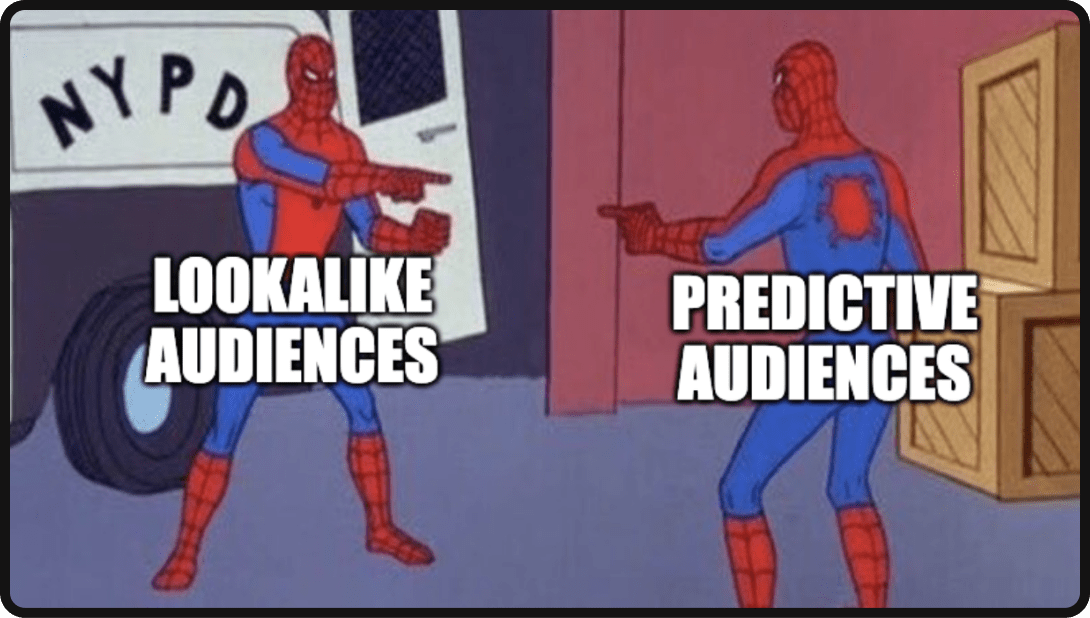LinkedIn’s removal of lookalike audiences has some advertisers worried. Rest assured, fellow marketers. There are two super-similar alternatives ready to go.
Here’s what we’ll cover:
- Does LinkedIn do lookalike audiences?
- What is the difference between predictive and lookalike on LinkedIn?
- What is LinkedIn’s audience expansion feature?
- What is a LinkedIn matched audience?
- What is the difference between matched and saved audiences on LinkedIn?
- Who is LinkedIn’s target audience?
- Final Thoughts
Does LinkedIn do Lookalike Audiences?
Not anymore. On February 29th, 2024, it’s over. LinkedIn will be officially retiring its lookalike audience targeting feature launched in 2019.
Lookalike audiences are widely used by advertisers to expand their existing user base and ad viewers with people who resemble existing customers or other desirable cohorts. Anyone advertising on the platforms below can incorporate lookalikes into their advertising audiences (with some exceptions for products and services related to credit, housing, or lending).
- Snapchat
- TikTok
- YouTube
- Microsoft Advertising
That’s quite a lot! So, why is LinkedIn getting rid of them? It’s because they’re moving towards a more forward-looking approach to predict future behavior versus lookalikes, which work on behaviors from the past. The changes are so significant… it’s worth renaming the feature altogether.
Social platforms are collectively evolving, and one of the components of that evolution is AI incorporation. LinkedIn’s lookalikes will officially turn into the AI-powered predictive audiences feature (and also audience expansion). Will this make LinkedIn’s predictive audiences more formidable than those platforms above? Incorporating machine learning into predictive audience creation is likely just starting and will eventually make the jump to the other platforms before becoming the industry standard.
Meta and TikTok are already using machine learning to inform their ad delivery, feed presentation, etc., and AI incorporation in other capacities for social platforms is only expected to rise.
Marketers, if you’re reading this before February 29, now is the time to get your audience data in order to create your final lookalike audiences (if, for some reason, you still want to). LinkedIn says they’ll continue to function after the 29th as a “static audience.”
This means no more data will be factored into the development of your lookalike audience, and you can expect no additions or removals of audience members from here on out. No edits either. In other words, there’s not going to be any more continuous replenishing of your pipeline with new prospective leads.
The result? LinkedIn lookalike audiences will become “tapped out” for everyone, and how long that will take is a function of audience size, spend and goal … but there is no escape. Eventually, those who’ve incorporated lookalikes will have reached everyone that LinkedIn thought was relevant to them as of February 29th, 2024.
Rest assured, though, because LinkedIn has a few alternative features that are almost just as well as their lookalike counterpart. The first one of note is LinkedIn’s Predictive audiences.

What Is the Difference Between Predictive and Lookalike Audiences on LinkedIn?
Before we talk about how they’re different, it’s important to understand how they’re similar — because they’re very similar. Lookalikes are a functional equivalent to predictive audiences on Linkedin, just… with more data sources.
Here’s how LinkedIn defines Lookalike audiences:
”LinkedIn’s lookalike audiences [feature] combines the traits of your ideal customer with our rich member and company data to help you market to new professional audiences similar to your existing customers, website visitors, and target accounts.”
These are the data points LinkedIn used to create lookalikes:
- Profession
- Educational Background
- Skills
- Company Industry
- Employee Count
- Work History
- Interests & more
Age and gender weren’t on the table when it came to creating lookalikes on LinkedIn. Pre-2019, age and gender were actually incorporated into lookalike audiences on Facebook. This eventually contributed to civil suits that helped inform LinkedIn on which data to incorporate for their own lookalikes.
Now, when you take a look at how LinkedIn defines predictive audiences, it’s nearly identical. LinkedIn defines a predictive audience as one that’s composed “… of people with similar characteristics to your existing data source who are more likely to convert. To create a predictive audience, we combine your data source and LinkedIn’s AI to automatically generate a new custom audience to use in your campaigns.” Whoa, wait a second. AI? Does this mean targeting is getting better?
You can manually upload anywhere between 300 and 300,000 users to create a predictive audience on LinkedIn. The data points LinkedIn incorporates into creating predictive audiences are as follows:
- LinkedIn’s Lead Gen Forms
- Manually uploaded customer credentials
- Insight Tag Data (Insight tag data includes visits to your website, timestamp, IP address, referral platform or URL, browser, and device info.
The main one to celebrate here is “manually uploaded customer credentials.” This is the primary benefit of lookalikes, and it isn’t going away. Phew. This is the part of the blog post where fellow marketers can rejoice.

What Is LinkedIn’s Audience Expansion Feature?
LinkedIn defines “audience expansion” as a feature that shows “your ads to audiences with similar attributes to your target audience.” It’s fairly similar sounding to its description for lookalike and predictive audiences. LinkedIn’s audience expansion feature pairs quite nicely with predictive audiences for marketers who want to target users that have similar qualities to their audience of choice.
For example, if you’re targeting business professionals with experience in banking, LinkedIn’s audience expansion could incorporate a broader audience of finance.
It’s just one more way LinkedIn methodically increases your audience size with users who share similar characteristics with adjacent qualities you didn’t include in your original targeting.
What Is a LinkedIn Matched Audience?
Matched audiences let you manually upload lists of customers or even companies to reach on LinkedIn.
LinkedIn defines matched audiences as “…custom audience segments you can use as targeting selections in your advertising campaigns.” With matched audiences, you can actually hit specific segments of people. This is the most direct form of audience targeting because you’re reaching an exact group versus an interest-based group.
Matched audiences allow you to directly target users on LinkedIn who’ve:
- Visited a page on your website
- Engaged with your ad
- Viewed your video ad
- Submitted a lead
- Engaged with your company page or event
The use of matched audiences is perfect for retargeting because you can tap into folks that have already established a proven interest.
What Is The Difference Between Matched and Saved Audiences on LinkedIn?
Advertisers can create saved audiences by selecting specific demographics and interests that align with their target market and saving them for future campaigns. You can save a matched (or modified matched) audience too.
Saved audiences allow advertisers to target users based on predefined criteria such as job title, industry, company size, location, and interests. This is different from matched audiences, which are specific audiences composed of people you upload or create cohorts of based on specific behaviors like video views. Modifying a matched audience with member attributes can be saved for use in future targeting.
Examples of types of brands that benefit from saved audiences:
- Brands with numerous SKUs may want to target different audiences on a regular basis
- Brands that sell one product to different audiences may have different messaging and unique cohorts to deliver tailored creatives to.
- Brands who do A/B testing with audiences of all types can save audiences to avoid the need to manually build them out again.
- Brands who manually create matching or predictive audiences won’t have to produce/upload that audience again when creating campaigns unless they feel like refreshing the list with client-side data.
Who Is LinkedIn’s Target Audience?
LinkedIn’s target audience is business professionals. They come from diverse backgrounds, from seasoned executives to fresh-faced graduates eager to make their mark. LinkedIn’s users devour articles on market trends, career advice, and leadership insights. This is where B2B ads rule. Whether you’re a tech entrepreneur in Silicon Valley or a chef in Tokyo, LinkedIn provides a platform for revenue to grow.
LinkedIn users have more income than the average social media platform. A recent study from Statista showed that half of U.S. LinkedIn users earned more than $75,000. 21% of its user base earned somewhere between $50,000 and $74,999 and another 21% fell between $30,000 and $49,999. All but 12% earned less than $30,000 per year.
LinkedIn’s user base is one that’s goal-oriented. People connect on LinkedIn to achieve a handful of goals such as:
- Networking: At its core, LinkedIn is a networking platform, allowing professionals to connect with colleagues, peers, industry leaders, and potential clients. LinkedIn provides a convenient and efficient way to connect with individuals across industries and geographical boundaries.
- Career Advancement: LinkedIn serves as an online resume and portfolio for professionals, allowing them to showcase their skills, experiences, and achievements to a global audience. Whether actively job seeking or passively open to new opportunities, maintaining an updated LinkedIn profile can significantly enhance one’s visibility to recruiters and potential employers.
- Brand Building: Not just for businesses, but individuals too, LinkedIn is a platform for brand building and thought leadership. You can establish trust on LinkedIn more than you can on other platforms. By regularly sharing insights, industry news, and original content, users establish themselves as experts in their field and build credibility within their professional community.
- Learning and Professional Development: LinkedIn is a treasure trove of resources for learning and professional development. Through features like LinkedIn Learning, users can access thousands of courses covering topics ranging from technical skills to leadership development. Additionally, engaging with industry-specific content and participating in discussions within LinkedIn Groups can broaden one’s knowledge and keep them informed about trends and best practices in their field.
- Lead Generation and Business Development: For businesses, LinkedIn offers opportunities for lead generation and business development. Through targeted advertising, content marketing, and outreach efforts, companies can attract potential clients, customers, and partners. LinkedIn’s advanced search features also allow businesses to identify and connect with decision-makers and key stakeholders within their target industries or organizations.
- Recruitment and Talent Acquisition: LinkedIn is a go-to platform for recruitment and talent acquisition. Employers can use the platform to post job listings, search for candidates based on specific criteria, and engage with passive talent. With features like LinkedIn Recruiter, companies can streamline their hiring process and reach a larger pool of qualified candidates.
Final Thoughts
Lookalike audiences are going away for good on LinkedIn, but for all intensive purposes, you can still reach people who resemble folks in lists you manually upload with predictive audiences.
While lookalikes’ original targeting options appear to have been limited, the ability to manually upload leads and target folks who resemble them didn’t go anywhere. In fact, AI is now enhancing that audience creation process. Could ROI go up from here?
Curious to see what AI can do for audience creation and ROI…






